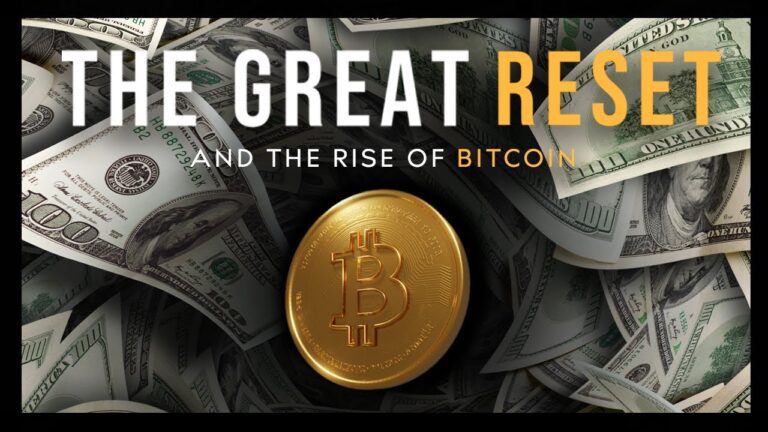What Preppers Must Know About Crypto 2022
Global Events Are Causing Changes
The government tyrany used against the Truckers in Canada, and the sanctions being placed on Russia are making it clear that a DECENTRALIZED CRYPTOCURRENCY is needed in this AGE OF BIG BROTHER – MARK OF THE BEAST 666 world we now live in.
It’s been postulated that the Ukrainian war is being used to speed up the introduction of THE GLOBAL GREAT RESET DIGITAL CURRENCY.
The only escape from this will be a PRIVATE/ANONYMOUS CRYPTOCURRENCY – see
CryptoGrizz.com for crypto privacy


What Preppers Need Know About Cryptocurrency 2022
What Preppers Need Know About Cryptocurrency 2022
Global Events Push Crypto To Forefront In 2022
Both the Trucker Protest in Canada and the sanctions against Russia in the Ukraine war have had a huge impact on Bitcoin and cryptocurrency in general.
All these events have pushed crypto to the forefront as a means of getting around financial censorship.

A Crypto Primer: What Preppers Need to Know
(Dominic Truces) Cryptocurrencies can be incredibly confusing, and for many, this leaves them wishing for a 101 class – a crypto primer, if you will – to help them to understand this magical internet money.
Related Bitcoin’s Sudden Acceptance As Global Finance Changes
by Dominic Truces, December 17th, 2021
That’s the phrase I first used, somewhat jokingly, to describe Bitcoin to some crypto-naïve friends back in 2012. Blockchain has come a long way since then, but a lot of people still either describe it this way or have a conception which boils down this. At the time though, it did feel somewhat magical, despite the fact that the first primary use cases centered around illicit activity (which left an indelible taint that haunts the blockchain industry to this day).
Most people have only recently become aware of cryptocurrency and blockchain. Consequently, most people have no idea of its origins or what things were like in the early days. Bitcoin used to be something far different than it is today.
In the early days of Bitcoin, because few people really understood how it worked, investors would send and receive units of Bitcoin to gain a better understanding of the investment they had made. They saw their BTC leave one wallet and enter another wallet within seconds.
During the early 2010s, instantaneous payment tools such as Venmo, Cash App, Apple Cash, and Zelle did not exist. Options for sending money were limited. An ACH transfer took several days and wiring money could take several hours at a cost of around $25, whereas Bitcoin fees were less than a cent. Bitcoin had a magical feel to it.
Bitcoin used to be fast, cheap, and actually used for transactions. At least, that’s how it was for the people who actually went through the hassle of getting a wallet, downloading the entire blockchain onto your computer to have a copy of every single transaction stored locally, finding a miner or someone else willing to sell you Bitcoin, and paying them directly to send it to you. The only alternative for most people to get Bitcoin was Mt. Gox, initially created to trade Magic: The Gathering cards, but was well known for being an extremely risky proposition.
It was a hassle only tech nerds and people with few other options would push through. But it was what it purported to be: a peer-to-peer electronic cash system.
So what happened? Why is the Bitcoin we see today expensive to transfer and largely marketed as a “store of value” and “digital gold” instead of peer-to-peer electronic cash?
In a word, Blockstream happened, but its far more complex than that.
To get a better understanding, a brief history lesson will help
Remember that indelible taint from the first use cases? The Bitcoin community didn’t want crypto relegated to the status of a dark web currency for criminals and tried to reign itself in. The Bitcoin Foundation was created in 2012 and brought on the protocol’s lead developers to improve its image.
That didn’t work. Much of the community criticized the Foundation for trying to work with government and regulators to improve Bitcoin’s image, and the presence of high-profile disasters such as the Mt. Gox CEO resigning from the board after the exchange’s collapse (and the arrest of another board member for involvement in the Silk Road drug incident) did little to help.
In 2014, a lot of the developers banded together to try and fix things. They started Blockstream to develop an ecosystem of companies and developers building “trustless cryptographic infrastructure.”
It originally sounded like a good idea. Bitcoin had previously grown completely organically and the number of altcoins had begun to grow substantially, most of which have since effectively disappeared. Organizing the development of the industry certainly seemed like a great way to streamline the entire ecosystem, which was starting to explode as more and more development teams continually created more and more forks, currencies, and projects in the space.
But Blockstream, like many startups, went out and raised money from venture capitalists. As a result, they ended up at least partially owned by a lot of large financial institutions.
Mainstream adoption of Bitcoin posed a serious threat to the powers that be
A digital asset that you can own and hold outside a centralized system poses a serious threat to legacy finance and the people who control the global monetary system.
The WEF brags that by 2030, we will own nothing, but we’re already almost there. How much physical cash do you have, versus what’s in your bank and credit accounts? How many physical stock certificates do you possess, versus what’s in your 401(k) prospectus? How many people reading this truly own their homes?
In truth, we own almost nothing. Even if you have a fully paid off house, the government still owns it via property taxes which they can raise until you’re unable to pay them if they really want to tighten the screws. Bitcoin threatened this by enabling an alternative system for ownership of everything that stood entirely outside their control.
This is why it had to be stopped.
Bitcoin had to be crippled for the global elite to maintain their control.
Most people don’t know that the original Bitcoin protocol was far different than it is today. Bitcoin, as represented by BTC, was intentionally crippled by Blockstream after they started receiving large investments. They deliberately broke Bitcoin by limiting the block size and removing all its extra functionality.
This was done ostensibly to preserve decentralization, but in practice all it did was eliminate almost every use case for Bitcoin. It drove up transaction fees, greatly limited transaction speeds, and made it so all you could do with Bitcoin was send it from one person to another, albeit much more slowly and costly than in the early years.
The developers who have assumed control of the main Bitcoin code value decentralization so highly that they intentionally prevented Bitcoin from achieving scale. By imposing technical constraints on the amount of data that could be written to the Bitcoin database and removing the native programming language which enabled much of Bitcoin’s functionality, the initial developers of Bitcoin transformed BTC into what they consider to be state-free money or “digital gold”. One of Multicoin Capital’s three “crypto mega theses” is that global state-free money, like BTC, will be able to capture a market they value at $100 trillion.
Destroying Bitcoin’s scalability resulted in a network that is slow and expensive, even at a level of usage that is miniscule relative to the valuation of the currency. Today (5/1/2020), BTC’s transaction fees hover at around $1.80 but have reached as high as $50 in times of peak traffic. BTC’s lack of scale has eliminated the possibility for most of Bitcoin’s revolutionary features and use cases. Since BTC’s only remaining value proposition is trustless, censorship resistant “digital gold,” which necessitates that the network doesn’t scale, BTC indeed does not scale. With scale topping out at around seven transactions per second, we don’t see how mainstream adoption is feasible.
This is not what it was supposed to be. This is not the peer-to-peer electronic cash Satoshi described.
So what actually is Bitcoin now, if its no longer what it was originally supposed to be?
I regularly see accusations leveled at Bitcoin.
- It’s a government honeypot.
- It’s a Ponzi scheme.
- Its backed by nothing and has no intrinsic value.
- It will be useless in an SHTF scenario.
In truth, it is all of these and none of these at the same time.
It’s highly unlikely that Satoshi was some government operative. I personally believe Satoshi was wise to go into hiding, as the likelihood of assassination was probably rather high. It may come out that one of the people claiming to be Satoshi actually is, but its highly improbable that he glows in the dark.
However, it makes sense that people believe that. Crypto certainly looks like the sort of scheme a government operative would dream up, and the growing talk of Central Bank Digital Currencies (CBDCs) certainly gives that theory more credence. However, CBDCs are a perversion of crypto, not a successor to them.
The idea of Bitcoin as a honeypot revolves around the store-of-value narrative, but Bitcoin was never supposed to be a store of value. It was supposed to be a publicly accessible database, which enabled payments from one person to another by accessing database records and writing new information.
That’s the electronic cash system
A mechanism to directly transfer money by moving it from one account in a publicly accessible ledger to another without having to go through an intermediary and attaching any additional information to that transfer you need for the transaction to be properly understood.
The store-of-value narrative has indeed effectively created a pseudo-Ponzi scheme. It was certainly not designed to be a scam, but the crippling of Bitcoin and reduction to one use-case has made it into a game of musical chairs. Everyone will make money as long as everyone holds, but eventually people will start cashing out and someone will be left without a chair.
In truth, this describes pretty much every asset. Early buyers benefit from price appreciation and push the price down when as sell. The difference is that with other assets like stocks, you own something which continually produces revenues.
Bitcoin, and other cryptos, by and large produce no revenues. There are exceptions, but those of us working on such projects generally avoid describing them that way lest we summon the wrath of the SEC. And so the assertion that cryptocurrencies have no underlying value has merit, although there are security tokens which are effectively company stock, tokens which are backed 1-to-1 by precious metals in audited reserves, and tokens which enable holders to earn stablecoins (cryptocurrencies pegged 1-to-1 to another asset, usually a fiat currency and most commonly USD) that can be quickly cashed out.
It is also true that none of this will matter if you are a prepper, because when SHTF, no asset which relies on the internet or electricity will have any utilization. However, insofar as cryptocurrencies are concerned, this will only affect you if you make the foolish mistake of not keeping your crypto in a wallet or if everything falls apart.
If the latter happens, the best preps will likely be food, lead, and pharmaceuticals. In an SHTF scenario where the internet doesn’t completely go down, crypto might actually be preferred in certain situations. It all depends on what actually happens, and since we can’t accurately predict the future, all we can do is hedge against possible scenarios.
One other accusation that is often leveled at Bitcoin, and crypto in general, is that the government can simply “turn it off”. This is entirely false – preventing this has always been one of the industry’s major drivers. The only way for the government to “turn off” crypto, or to block you from accessing it, is to completely shut down the internet. Even then, assuming you didn’t make Crypto Mistake Number One and fail to put your crypto in a wallet, you will still own and have access to your entire portfolio.
If you put your crypto in an offline paper wallet, you can even trade it the same way you would trade physical currency. Granted, if the internet was completely offline then nobody would be able to verify that the paper wallet was indeed loaded with the amount of crypto you said it had, but there are ways around that issue and your assets would be secured either way. Most people who have been in crypto for a long time hold much of their assets in paper wallets.
Regardless, all of these issues have arisen because Bitcoin itself was intentionally crippled. If that hadn’t happened, you wouldn’t even be reading this because the questions surrounding Bitcoin’s usefulness by and large wouldn’t exist. Similarly, all the problems with the various tokens that have been built on top of various blockchains mostly come from the fact that they’re built on flawed blockchains. Had BTC been allowed to persist in its original form, most of these tokens that address niche issues would have far fewer issues.
Why Bitcoin and not one of the many other altcoins?
Up until now I’ve focused almost entirely on Bitcoin because that’s the one almost everyone who isn’t in the blockchain space things of when they think of crypto. Further, most people attribute all the flaws and accusations towards Bitcoin to all the other projects in the space.
There’s some truth to that assertion. The ICO craze of 2017-2018 certainly did the space no favors. Also, many of the alternatives that have proliferated are inherently damaged by their progenitor. They all try to solve niche problems with Bitcoin while keeping the rest of the puzzle intact, without realizing that isn’t really possible.
Computer scientists will nitpick my explanation of “global state” in this context, but in a blockchain context, what is typically meant by global state is the ability for transactions to access the information about any account or smart contract. This is critical for DeFi.
DeFi is built on the idea that smart contracts can follow one another and execute automatically as things happen within the blockchain ecosystem. This transparency and interactivity is the selling point.
…
The problem is the interdependence of transactions. All of the information needed to process a transaction is not within the transaction itself. One has to reference that transaction against the global state. If a smart contract wants to send ether from you to me, it needs to check that you have the ether. Depending on the ordering of transactions, the results could be totally different. This requirement ultimately demands serial processing of transactions – processing them one after another in the same order by every network operator. Optimizations can be made, but the same problem will always rear its ugly head.
Whether they envision crypto as a global supercomputer, a censorship-resistant store of value, a fully anonymous peer-to-peer currency, or something else entirely, almost every alternative to Bitcoin focuses on addressing one niche problem created by the crippling of the original Bitcoin protocol. This was why Bitcoin Cash (BCH) and Bitcoin SV (BSV) were spun off from BTC – their creators intended to restore what they saw as Bitcoin’s original functionality.
It’s important to note that there’s a difference between tokens, which are Layer 2 solutions, and native coins, which are Layer 1 blockchains.
Projects like Monero (XMR), Cardano (ADA), Solana (SOL), Dogecoin (DOGE), and Ethereum (ETH) are Layer 1 blockchains like Bitcoin. They run on their own networks. They exist independent of every other crypto asset and would still work even if every other crypto died tomorrow.
Layer 2 solutions are tokens built on top of the Layer 1 blockchains. Tether (USDT), Shiba Inu (SHIB), Uniswap (UNI), Chainlink (LINK), Basic Attention Token (BAT), and Filecoin (FIL) are all examples of Layer 2 solutions. They are tokens built on top of other blockchains, and as a result they require the user to hold some of the base blockchain token to use them. BAT, for example, is built on ETH. Sending or using BAT requires you to have some ETH in the same wallet address.
The Layer 2 solutions address a very different set of issues than the Layer 1 blockchains. Most of the Layer 2 tokens can be deployed on any Layer 1 chain that supports tokens. Most choose Ethereum, but there are many options, and a lot of projects deploy on multiple chains.
Personally, it is my belief that there are a series of reckonings coming for the blockchain industry. While most governments have permitted most cryptos to forge ahead, it seems increasingly likely that many authorities will drop a nuke on most alternative projects that are operating on the fringes of “security” status within short order. When that happens, many major projects will vanish quickly or see their valuations plummet. That will be the first reckoning, and probably around 90% of projects will die.
The second reckoning will be for projects that aren’t working closely with the authorities in some way. A lot of projects in the cryptocurrency space have a “screw the authorities” mindset, even if they are nominally compliant. It’s pretty inherent in the space, and is one reason the assertion of being a government honeypot often leveled at the entire industry is so amusing.
Regardless, even though most legitimate projects are run by preppers, libertarians, anarcho-capitalists, and those of similar ideologies, (all of which are often targeted) many of them recognize the need to play by the rules lest they get crushed by the government. Those projects, especially the ones built on top of Bitcoin, Ethereum, and their forks, will likely be the only ones that survive the second reckoning which will probably claim another 75% of those which remain.
Each of these reckonings will push up the value of all remaining projects, but eventually there will probably only be one single Layer 1 chain which survives. The projects built on it will do well, while the others will have to quickly redeploy onto it or die.
I have a theory as to which blockchain this will be, and it’s not an extremely popular one, but only time will tell. BTC has the momentum and the branding, but when you see blockchain and crypto as a public database rather than a niche solution or a store of value, what blockchains actually are and which one will likely be the last one standing become far clearer.
What are your thoughts?
What do you think about cryptocurrency? Does this article explain it thoroughly? Even if you’d never use them, do you understand them better? Let us know in the comments.
About The Author
Dominic Truces
Dominic Truces is a serial entrepreneur who has lived all over the US. He’s launched projects in industries ranging from humanitarian relief to decentralized finance. He does his best to remain an impartial conveyor of raw information, but urges everyone to do their own research and synthesize their own conclusions rather than just listening to what they’re told, no matter how big the speaker’s megaphone might be (including himself).
Stillness in the Storm Editor: Why did we post this?
The news is important to all people because it is where we come to know new things about the world, which leads to the development of more life goals that lead to life wisdom. The news also serves as a social connection tool, as we tend to relate to those who know about and believe the things we do. With the power of an open truth-seeking mind in hand, the individual can grow wise and the collective can prosper.
– Justin
Not sure how to make sense of this? Want to learn how to discern like a pro? Read this essential guide to discernment, analysis of claims, and understanding the truth in a world of deception: 4 Key Steps of Discernment – Advanced Truth-Seeking Tools.
Stillness in the Storm Editor’s note: Did you find a spelling error or grammatical mistake? Send an email to corrections@stillnessinthestorm.com, with the error and suggested correction, along with the headline and url. Do you think this article needs an update? Or do you just have some feedback? Send us an email at sitsshow@gmail.com. Thank you for reading.
Source:
https://www.theorganicprepper.com/a-crypto-primer-what-preppers-need-to-know/
PROFIT FROM THE COMING STOCK MARKET MELTDOWN BY USING PRIMEXBT TO SHORT THE NASDAQ AND S&P 500 USING LEVERAGE
Read More: Profit From Stock Market Meltdown
What Preppers Need Know About Cryptocurrency 2022
BROUGHT TO YOU BY:

VISIT OUR OTHER SITES:
Check Out Our Crypto Privacy Site: CryptoGrizz.com
Check Out Our Crypto Trading Site: CryptoGrizzTrader.com
Check Out Our Low Cap Altcoin Site: CryptoGrizzAltcoins.com
Check Out Our Prepper Site: PrepperGrizz.com
Check Out Our Prepper Survival Site: PrepperSurvival.org
Check Out Our Global Crypto Survival Site: GlobalCryptoSurvival.com


Pingback: Glenn Beck Outs Banks For Lying To Us – Crypto Trader
Pingback: Glenn Beck Asks Is China Our Future? – Crypto Trader
Pingback: How To Profit From The Coming Stock Market Meltdown – Crypto Trader
Comments are closed.